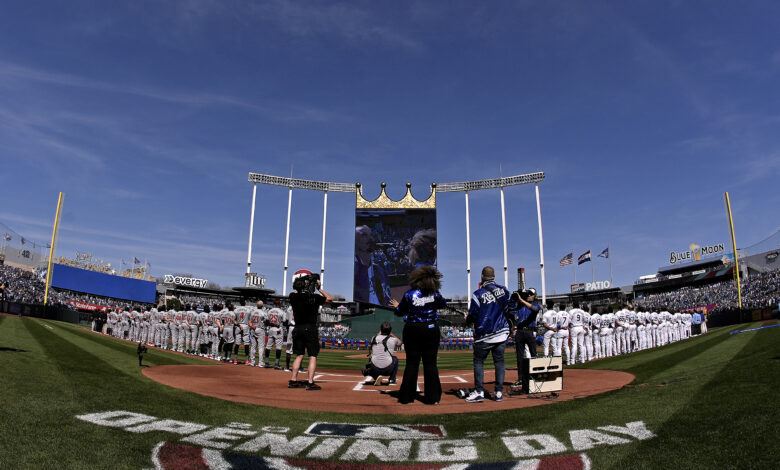KC residents vote on a new stadium tax that could determine the future for Chiefs and Royals

(AP) — The future of the Royals and Chiefs in Kansas City was being shaped Tuesday as residents of Jackson County, Missouri, voted on whether to extend a sales tax to help to pay for a new downtown ballpark and major renovations to Arrowhead Stadium.
In what is expected to be a close ballot measure, voters were being asked to essentially replace the existing three-eighths of a cent sales tax that has been paying for the upkeep at the Truman Sports Complex — the home of Kauffman and Arrowhead stadiums for more than 50 years — with a new three-eighths of a cent tax that would be in place for the next 40 years.
The Royals, who have pledged at least $1 billion from ownership for their project, would use their share of the tax revenue to help fund a $2 billion-plus ballpark district, while the Super Bowl-champion Chiefs — who have committed $300 million of their own money — would use their share as part of an $800 million overhaul of Arrowhead Stadium.
“We’re the second-smallest city with both an NFL franchise and a Major League Baseball club, and we want to sustain ourselves as a major league city,” said John Sherman, the Kansas City businessman who purchased the Royals five years ago. “We want to make sure these franchises thrive here for another 50 years.”
As part of new lease terms, the franchises have pledged $260 million, or about $3.5 million annually, that a committee appointed by the county and teams would funnel toward social and economic causes in the community.
“I think it’s a great project for the city,” said Chiefs coach Andy Reid, who voted early Tuesday. “I lived this in Philadelphia. I went through the same type of project there. And right when you don’t think it’s going to get done, it gets done.”
Neither franchise has said what it would do if the tax fails, only that they would explore all their options, which would include leaving Kansas City. The current lease at the Truman Sports Complex lasts through Jan. 31, 2031.
The tax extension — or, more accurately, the stadium plans — has been met with significant public pushback.
Last fall, the Royals unveiled two potential locations for their ballpark district, one on the eastern edge of downtown and the other across the Missouri River in Clay County, Missouri. But they kept pushing back a self-imposed deadline to finalize their location, and in February, they announced they had scrapped both concepts for a different downtown location.
The new area, known as the Crossroads, has a vibrant arts and restaurant scene, and it is just blocks away from the T-Mobile Center and the bustling Power & Light entertainment district. It also is close to the Kauffman Center for the Performing Arts and the 18th & Vine district, which is home to the Negro Leagues Baseball Museum.
“I think everyone has the same mixed feelings,” said Deidre Chasteen, a voter from Independence, Missouri, who remembers attending games downtown at old Municipal Stadium when the Royals played there from 1969-72.
“It’s not that we mind paying the three-eighths-cent sales tax. I think the problem is putting the stadium where it is,” she said. “We’re not saying they don’t need a new stadium. We’re saying don’t ruin businesses that have been established down there for years.”
There were plenty of questions weighing on voters’ minds.
For one thing, the latest ballpark renderings were made obsolete just last week when the Royals acquiesced to Mayor Quinton Lucas’ request that a major street that would have been part of the stadium footprint remain open. Lucas did not endorse the tax initiative until late last week, after the Royals agreed to the change.
The club also has not reached sales agreements with many landowners in the Crossroads, and other businesses have expressed concerns about traffic, congestion and parking in an already thriving neighborhood.
“A lot of that will be discussed after April 2 with the city and the neighborhood,” Sherman said, adding that he believes many of “their businesses will boom” when the stadium drives thousands of fans downtown at least 81 times a year.
Sarah Tourville, the Royals’ executive vice president, said the goal is to move into the stadium for opening day in 2028.
The Royals moved from Municipal Stadium to Kauffman Stadium in 1973 and extensively renovated the ballpark from 2009-12. Arrowhead Stadium was built alongside Kauffman Stadium and also was renovated around the same time.
While the Royals insist on playing in a new ballpark, the Chiefs want to stay put with a renovation that would touch every aspect of their 52-year-old building, from the seating bowl to luxury amenities and improvements to the tailgating scene.
“We would not be willing to sign a lease for another 25 years without the financing to properly renovate and reimagine the stadium,” said Chiefs chairman Clark Hunt, whose father Lamar Hunt helped get the existing stadiums built. “So the financing puzzle is very important to us to make sure we have enough funds to do everything we’ve outlined.”
The Chiefs hope their recent success, including three Super Bowl titles in the last five years, will help to sway voters.
“What my dad loved best about the stadium was the connection the team had with our fanbase,” Hunt said. “He loved this building for what it means to the fans, and we still believe it is one of the best stadiums in the National Football League and a bucket-list destination for fans across the NFL.”



